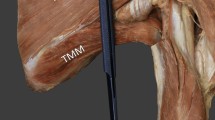Abstract
Purpose
The rotator cuff concept refers to the four scapulohumeral muscles that stabilize and rotate the humerus relative to the scapula. To date, the first description of the rotator cuff remained unidentified.
Method
In light of the 500th birthday of Andreas Vesalius (1515–1564) we searched his 1543 masterwork “Fabrica Corporis Humani Libri Septem” for references to the morphology and function of the rotator cuff muscles.
Result
Even though he distinguished three rather than four scapulohumeral muscles, Vesalius recognized the need for structures that prevent dislocation of the shoulder inherent to the morphology of the humeral caput and scapular socket. He recorded “three strong ligaments” and the “three muscles that rotate the arm” of which the tendons completely “embrace the ligaments of the joint” as such structures.
Conclusion
Vesalius defined the rotator cuff concept avant la lettre.


Similar content being viewed by others
References
DePalma A (1983) Rotator cuff. In: DePalma A (ed) Surgery of the shoulder, 3rd edn. Lippincott, Philadelphia
Barr K (2004) Rotator cuff disease. Phys Med Rehabil Clin N Am 15:475–491
Clement ND, Nie YX, McBirnie JM (2012) Management of degenerative rotator cuff tears: a review and treatment strategy. Sports Med Arthrosc Rehabil Ther Technol 4:48
Williams G, Gillespie R (2012) Why does the rotator cuff fail? The pathophysiology of rotator cuff disease. In: Maffulli N, Furia JP (eds) Rotator cuff disorders: basic science and clinical medicine. JP Medical, London
Matsen F, Fehringer E, Lippitt S et al (2009) Rotator cuff. In: Rockwood C, Matsen F (eds) The shoulder, 4th edn. Saunders, Philadelphia, pp 771–890
Vesalius A (1998) De humani corporis fabrica libri septem - 1543. Basel, Octavo Corporation, Palo Alto
Richardson WF, Carman JB (1999) Andreas Vesalius on the fabric of the human body, Book II: The ligaments and muscles. Norman, San Francisco
Eriksson R (1959) Andreas Vesalius’ first public anatomy at Bologna 1540—an eyewitness report by Baldasar Heseler. Almqvist & Wiksells Boktryckeri, Uppsala
DePalma A (1983) Biomechanics of the shoulder. In: DePalma A (ed) Surgery of the shoulder, 3rd edn. Lippincott, Philadelphia, pp 65–85
Saunders JBM, O’Malley CD (1982) The anatomical drawings of Andreas Vesalius. Bonanza Books, New York
De Maeseneer M, Van Roy P, Shahabpour M (2006) Normal MR imaging anatomy of the rotator cuff tendons, glenoid fossa, labrum, and ligaments of the shoulder. Radiol Clin N Am 44:479–487
Conflict of interest
The authors declare that they have no competing interests.
Author information
Authors and Affiliations
Corresponding author
Additional information
This research received no specific grant from any funding agency in the public, commercial, or not-for-profit sectors.
Rights and permissions
About this article
Cite this article
Brinkman, R.J., Hage, J.J. Andreas Vesalius’ five hundreth anniversary: initiation of the rotator cuff concept. International Orthopaedics (SICOT) 39, 2511–2513 (2015). https://doi.org/10.1007/s00264-015-2823-6
Received:
Accepted:
Published:
Issue Date:
DOI: https://doi.org/10.1007/s00264-015-2823-6




